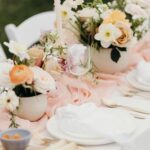Are you looking to add a pop of color and visual interest to your next cake creation? In this article, we will delve into the art of cake decoration with a focus on using two different colors to elevate the overall aesthetic. Whether you are a novice baker or a seasoned pro, learning how to decorate a cake with 2 different colors can take your confectionery skills to the next level.
Cake decoration is not just about making a delicious dessert look pretty; it is an art form that allows for creativity and personal expression. Using two different colors on a cake can add depth and dimension, creating a visually stunning masterpiece that is sure to impress. The appeal of multi-colored cakes lies in their ability to capture attention and evoke delight, making them perfect for special occasions or simply as a fun and eye-catching treat.
In the following sections, we will explore the process of choosing the right type of frosting, preparing the cake, mixing and applying the colors, using piping techniques, adding additional decorations, and providing tips for success in creating a beautifully decorated multi-colored cake. Whether you are aiming for a simple yet elegant design or an intricate work of art, mastering this skill will undoubtedly elevate your baking game.
Let’s roll up our sleeves and get ready to explore the world of multi-colored cake decoration.
Choosing the Right Type of Frosting
When it comes to decorating a cake with two different colors, choosing the right type of frosting is crucial. The most popular choices for creating a multi-colored cake are buttercream and fondant. Buttercream is a smooth and creamy frosting that is easy to work with, making it ideal for beginners. On the other hand, fondant provides a sleek and seamless finish, perfect for creating elaborate designs and patterns.
Buttercream is often preferred for its taste and texture, while fondant offers a more polished look. Ultimately, the choice between the two comes down to personal preference and the desired outcome of the cake. If you’re planning to create a multi-colored cake with intricate details and designs, fondant may be the better option. However, if you prioritize flavor and simplicity, buttercream would be the way to go.
Both buttercream and fondant come in various colors, allowing for endless creative possibilities when decorating a cake with two different colors. It’s important to ensure that your chosen frosting type can hold its shape when layered or piped onto the cake in order to achieve the desired effect.
When deciding on which type of frosting to use, consider not only your design vision but also your skill level and experience in working with different types of frosting. In any case, mastering either buttercream or fondant will open up a world of creative opportunities when it comes to decorating cakes in multiple colors.
| Frosting Type | Advantages |
|---|---|
| Buttercream | Smooth and creamy texture; easy to work with; great taste |
| Fondant | Sleek finish; ideal for intricate designs; available in various colors |
Preparing the Cake
Before you can start decorating your cake with two different colors, it’s crucial to ensure that the cake itself is prepared correctly. This includes choosing the right type of cake batter, baking it to perfection, and allowing it to cool completely before moving on to the decorating process.
When selecting a cake batter, it’s important to consider how well it will hold up to the weight of the frosting and decorations. A sturdy base, such as a dense chocolate or vanilla sponge, is ideal for multi-colored cakes.
Once you have chosen your batter, bake it according to the recipe instructions and check for doneness by inserting a toothpick into the center of the cake. If it comes out clean, your cake is ready to be removed from the oven.
After baking, allow the cake to cool completely on a wire rack. Decorating a warm or hot cake can cause the frosting to melt and slide off, resulting in a messy and unappealing finished product. Additionally, attempting to frost a warm cake can lead to crumbs mixing into the frosting, making it difficult to achieve a smooth finish.
Therefore, patience is key when preparing your cake for decoration. Once cooled, you can proceed with confidence knowing that your cake is ready for the next steps in creating a visually stunning masterpiece.
| Important Step | Details |
|---|---|
| Choosing cake batter | Select a sturdy base like chocolate or vanilla sponge. |
| Baking | Bake according to recipe instructions and check for doneness with a toothpick. |
| Cooling | Allow the cake to cool completely on a wire rack. |
Creating the Base Color
When it comes to decorating a cake with two different colors, one of the first steps is to create the base color. The base color will serve as the foundation for the entire design and will provide a backdrop for the second color to stand out. Here are some step-by-step instructions on how to mix and apply the first color of frosting to the cake.
Step 1: Choose Your Frosting
The type of frosting you choose will greatly impact the outcome of your cake decoration. Buttercream is a popular choice for creating a smooth and creamy base color, while fondant can offer a more polished and professional look. It’s important to consider the consistency and texture of the frosting to ensure that it spreads easily and evenly onto the cake.
Step 2: Mix Your Colors
Once you have selected your frosting, it’s time to mix your colors. Depending on the desired shade, you may need to add food coloring or gel coloring to achieve the perfect hue. It’s helpful to start with a small amount of coloring and gradually add more until you reach your desired color. Remember that you can always add more color, but you can’t take it away, so start with less and gradually build up.
Step 3: Apply Evenly
Once your base color is mixed, use an offset spatula or icing smoother to apply a generous layer of frosting onto the cake. Start from the top and work your way down the sides, ensuring that you spread the frosting evenly across all surfaces. It’s crucial to achieve a smooth and level application of this first layer as it will set the stage for adding in your second color seamlessly.
By following these simple steps, you’ll be well on your way to creating a beautiful base color for your multi-colored cake. This sets up an excellent canvas for transitioning into adding that second eye-catching hue that will truly make your cake stand out.
Adding the Second Color
After successfully applying the base color of frosting to your cake, it’s time to move on to adding the second color. This step is crucial in achieving a visually appealing and professional-looking multi-colored cake. Here’s how to decorate a cake with 2 different colors and ensure a seamless transition between the two:
1. Prepare the second color of frosting: Once you have mixed and tinted your second color of frosting, ensure that it is at the right consistency for spreading or piping onto the cake. If necessary, adjust the thickness by adding more powdered sugar for a thicker consistency or milk for a thinner consistency.
2. Blending the colors: To create a smooth transition between the two colors, use an offset spatula or a butter knife to gently blend where they meet. Make sure to work quickly but carefully to avoid mixing the colors together too much, as this can result in a muddy appearance rather than clean lines.
3. Transitioning between colors: Depending on your design, you may want to create defined lines between the two colors or blend them seamlessly together. Use your decorating tools – such as piping bags with tips or fondant shaping tools – to achieve your desired look and ensure that there is no harsh contrast between the colors.
Remember that practice makes perfect when it comes to mastering this technique. Don’t be afraid to experiment with different color combinations and blending methods until you achieve the exact effect you want on your cake. With patience and attention to detail, you’ll be able to create stunning multi-colored cakes sure to impress any guest or recipient.
4. Additional tip: If you’re decorating a layered cake, consider using different colors for each layer for added visual interest when sliced.
Using Piping Techniques
When it comes to decorating a cake with two different colors, using piping techniques can take your cake to the next level. Piping allows for intricate designs and patterns that can truly showcase the two colors of frosting. Here are some popular piping techniques to consider:
1. Shell border: This classic border adds texture and dimension to the edges of the cake and is created by piping small shells of frosting next to each other around the perimeter.
2. Rosettes: Create beautiful rosettes on top of the cake by swirling the piping bag in a circular motion, starting from the center and working your way outwards.
3. Cornelli lace: This delicate, lace-like design is perfect for blending two different colors of frosting. It involves creating looping and braiding patterns with a small round tip.
4. Basketweave: For a more complex look, try your hand at a basketweave pattern using both colors of frosting. This technique mimics the look of woven baskets and adds an interesting texture to the sides of the cake.
5. Writing or lettering: If you want to add a personalized message or decorative writing to your cake, use a piping bag fitted with a small round tip to carefully write out words or phrases in one color, then go over them with the second color for a bold, outlined effect.
By mastering these piping techniques, you can elevate the visual appeal of your multi-colored cake and impress your friends and family with your creativity and skill in cake decoration.
Adding Additional Decorations
When it comes to decorating a cake with two different colors, adding additional edible decorations can elevate the overall look and create a stunning visual impact. Whether you’re aiming for a playful, whimsical design or a more elegant, sophisticated finish, the right choice of edible decorations can enhance the aesthetic appeal of your multi-colored cake.
Choosing the Right Decorations
When selecting edible decorations for your cake, consider the theme or occasion. For example, colorful sprinkles or confetti-shaped edible decorations work well for birthday cakes and festive celebrations. On the other hand, delicate edible flowers or shimmering edible glitter can add an elegant touch to wedding cakes or special occasion desserts. It’s important to choose decorations that complement the color scheme and overall style of your cake.
Application Techniques
Once you’ve chosen your edible decorations, consider different application techniques to achieve various effects. Sprinkles can be gently pressed onto the frosting while it’s still soft, creating a fun and textured appearance. Edible glitter can be applied by lightly dusting it over the frosted surface for a subtle shimmer. When using edible flowers, carefully place them on the cake to create a visually appealing arrangement. Experiment with different placement and distribution methods to achieve the desired look.
Final Touches and Presentation
After adding the edible decorations, take some time to evaluate and make any necessary adjustments to ensure that they are evenly distributed and visually balanced across the cake. Pay attention to symmetry and spacing when placing decorations, as these details contribute to an overall polished presentation. Additionally, consider incorporating complementary non-edible elements such as ribbons or decorative cake toppers to further accentuate the theme or occasion.
By incorporating these additional decorations into your multi-colored cake design, you can transform it into a show-stopping centerpiece that impresses both visually and in taste.
Tips and Tricks for Success
When it comes to decorating a cake with two different colors, there are several tips and tricks that can help you achieve a professional-looking result. One of the most important tools for successful cake decorating is a turntable. A turntable allows for easy frosting application and smooth rotations as you work on different parts of the cake. This makes it easier to create clean, sharp edges and ensures an even distribution of the frosting on the cake.
Another helpful tip for achieving a multi-colored cake is to use a crumb coat before applying the final layer of frosting. A crumb coat is a thin layer of frosting that seals in any loose crumbs on the surface of the cake, preventing them from mixing into the final layer of frosting. This step is crucial when working with two different colors, as it helps to maintain the distinctiveness of each color and achieve a clean, polished look.
In addition to using a turntable and applying a crumb coat, it’s also important to have the right tools for creating different patterns and designs with the two colors of frosting. Piping bags and various piping tips can be used to create intricate designs, shapes, and borders on the cake. By experimenting with different piping techniques, you can add visual interest and dimension to your multi-colored cake, taking your decoration skills to the next level.
Overall, by following these tips and tricks for success in decorating a cake with two different colors, you can achieve a professional-looking result that is sure to impress your friends and family. Whether you’re creating a birthday cake or a special dessert for an event, these techniques will help you take your cake decorating skills up a notch and create visually stunning treats that taste as good as they look.
Conclusion
In conclusion, decorating a cake with two different colors can add an extra element of visual interest and creativity to your baking endeavors. From choosing the right type of frosting to preparing the cake and applying the colors in a smooth, seamless way, there are several key points to keep in mind when embarking on this type of cake decorating project.
By following the outlined steps and utilizing various piping techniques, anyone can achieve a beautifully decorated multi-colored cake that is sure to impress.
Whether you’re a beginner or experienced baker, don’t be afraid to experiment with different color combinations and decorations to make your cake truly unique. With the right tools, ingredients, and techniques, it’s entirely possible to create a professional-looking multi-colored cake that will be the star of any celebratory occasion.
So go ahead and give it a try – you may discover a newfound passion for cake decorating and delight your family and friends with your stunning creations.
In the end, the most important thing is to have fun and enjoy the process of creating something beautiful and delicious. So gather your supplies, follow the tips and tricks provided, and let your creativity soar as you decorate a cake with two different colors. You may be pleasantly surprised at what you can accomplish with a little patience and practice.
Frequently Asked Questions
How Do You Decorate a Cake With Two Colors?
Decorating a cake with two colors can be done in several ways. One common method is to use a piping bag to apply one color of frosting to the top and bottom of the cake, then switch to another color for the middle section.
Another option is to create a gradient effect by blending two colors together on the sides of the cake.
How to Make a 2 Tone Buttercream Cake?
Making a 2 tone buttercream cake involves preparing two separate batches of buttercream frosting in different colors. Once both frostings are ready, you can either layer them in the piping bag for a swirled effect or use an offset spatula to create smooth, distinct layers of each color on the cake.
How Do You Combine Colors in Cake Decorating?
Combining colors in cake decorating often relies on using food coloring and different techniques such as marbling, ombré, or creating specific patterns like stripes or polka dots with different colored frostings. It’s important to consider color theory and practice working with icing consistency to achieve the desired result when combining colors on a cake.

Welcome to my blog about home and family. This blog is a place where I will share my thoughts, ideas, and experiences related to these important topics. I am a stay-at-home mom with two young children. I hope you enjoy reading it! and may find some helpful tips and ideas that will make your home and family life even better!





